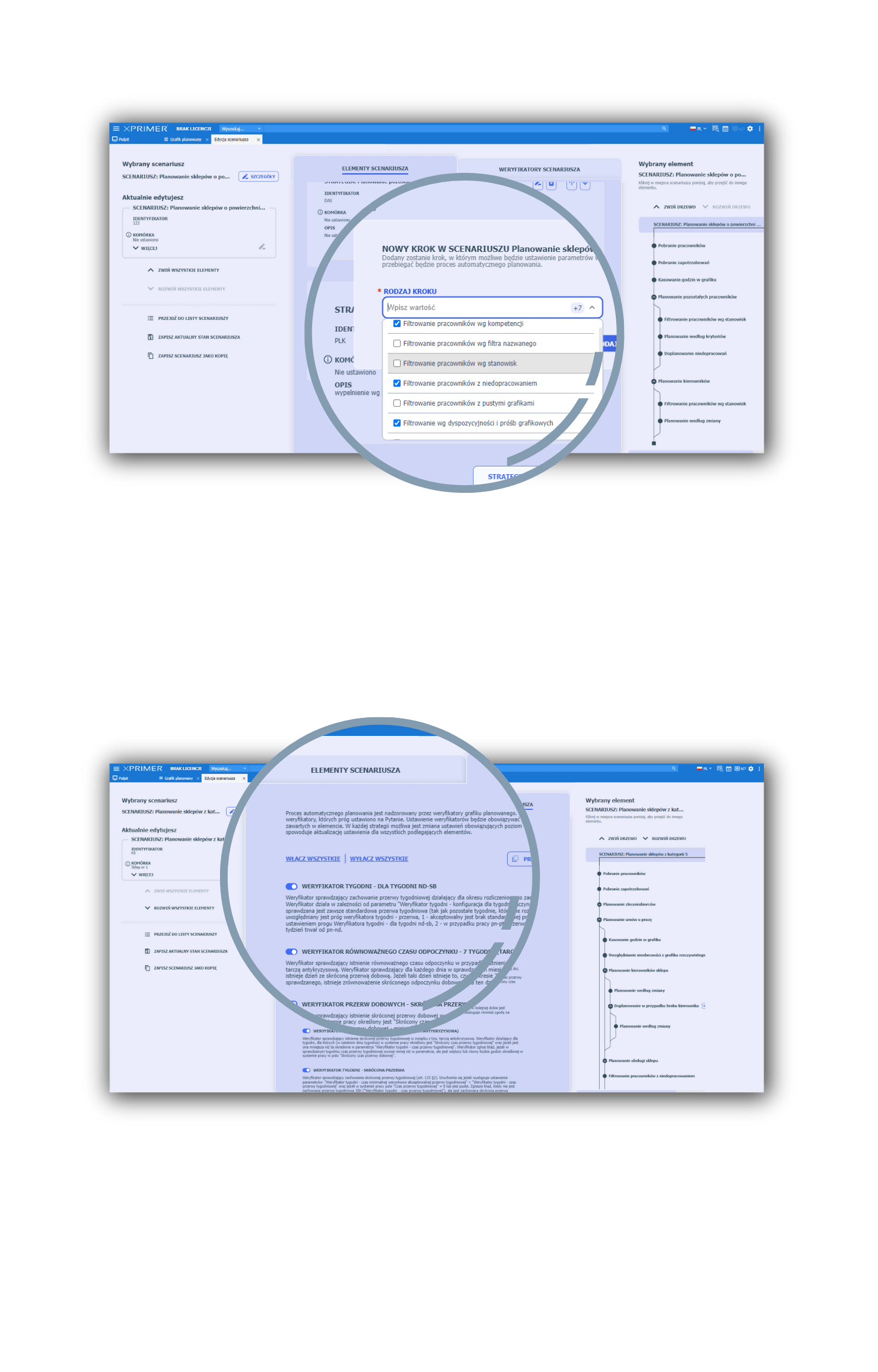XPRIMER.WFA
Working time planning
based on advanced
algorithms taking account
of your business realities
Working time planning
based on advanced
algorithms taking account
of your business realities
XPRIMER.WFA
XPRIMER.WFA - optimising employee time scheduling according to the needs of your business
Creating of work schedules can be made even more efficient and tailored to the peculiarities of company by using specific planning scenarios in which algorithms prepare the most optimal plan versions according to set criteria.
XPRIMER.WFA enables, among other, creating of work schedules according to business needs, set priorities, simulations of work schedules and the automatic consideration in staff planning of sudden changes occurring in the market.
With XPRIMER.WFA, you significantly reduce the labour intensity of the planning process, and the possibility to carry out plan simulations allows you to choose the best version of the plan.
The use of planning algorithms in XPRIMER.WFA means:

Ability to simulate schedules
which translates into action on the basis of reasoned decisions.

Selection of optimal planning scenarios
by using complex strategies, criteria and verifiers tailored to the organisation.

Guarantee of tasks’ completion
based on plans using actual staff requirements.

Supporting training policy
by detecting competency and qualification gaps more quickly.

Rapid adaptation to change
by automatically considering changes in labour demand and staff availability.

Increasing the precision of achieving goals
ensuring a staffing with the appropriate competences, qualifications and skills.
What are the advantages of XPRIMER.WFA?
Saving time
Staffing balancing based on knowledge of actual staff demand (including other forms of employment, b2b, temporary) translates into a significant reduction in the time needed to prepare an appropriate work plan.
Cost reduction
Automated scheduling reduces the administrative costs associated with the work scheduling process and the costs of substitutions/overtime caused by scheduling without consideration of the required staffing.
Higher productivity
Advanced time scheduling ensures that the right staff with the right competences are in the right place at the right time to complete tasks.
Greater flexibility
The use of planning scenarios allows schedules to be adapted quickly to changes resulting from the market environment.
Achievement of goals
Creating many different versions of schedules gives knowledge of the consequences/effectiveness of a particular scenario and the ability to choose the best option.
Effective managers
Planning using the most optimal scenarios enables managers to concentrate on tasks resulting from their responsibilities/competencies.
See how XPRIMER.WFA works in practice
Contact us and arrange a meeting, during which we will present how XPRIMER.WFA works.
Explore the functionalities of XPRIMER.WFA

Ensure task completion with optimal staffing
The starting point for scheduling working time according to the selected strategies is the number of employees required to complete production/customer service tasks.
Demand data can be imported or entered manually based on actual tasks or historical data.
Create scenarios tailored to business objectives
When starting an automatic scheduling operation, the user builds scenarios containing an appropriate number of scheduling strategies created from selected criteria parameterised to the needs of the organisation and defines their importance. Such criteria can be, for example: even scheduling of Sundays, Saturdays, holidays, compliance with the employee’s default shift, even distribution of the monthly norm in a given period and selected parameters from the employee’s file, e.g. hourly rate, employee skills, availability and roster requests.
Additionally, the scheduling algorithm applies user-selected verifiers in the scheduling (e.g. verifier for public holidays, weekend working system, minimum number of scheduled hours per day, or verifiers resulting from additional industry regulations or the organisation’s business rules).
The established criteria with their assigned weights and verifiers are an element of the working time planning strategy on the basis of which the planning algorithm creates the schedule.
It is possible to create and save scenarios with different strategies containing criteria and verifiers, so that when planning schedules, the user chooses the scenario that is most appropriate to the business objectives.


Adapt schedules to a dynamically changing situation
Once the algorithm has created a work plan, the user assesses whether a roster based on the defined strategy is in line with staffing requirements. As changes occur (e.g. unscheduled absences), the system immediately indicates staffing shortages and the user can react accordingly by changing the scenario and creating a new version of the plan.
Choose the most optimal version of the work plan
The algorithm allows you to repeatedly execute the planning operation and check how the staffing requirements are met for each scenario and how the assumed tasks will be carried out.
Depending on the number of employees and the complexity of a given scenario, a new roster is ready in a few minutes, at most.
Simulations of the plans allow you to predict the consequences of the application of a given scenario for the fulfilment of tasks in the context of the company’s business objectives.

See how XPRIMER.WFA works in practice
Contact us and arrange a meeting, during which we will present how XPRIMER.WFA works.
Explore XPRIMER user reviews





































